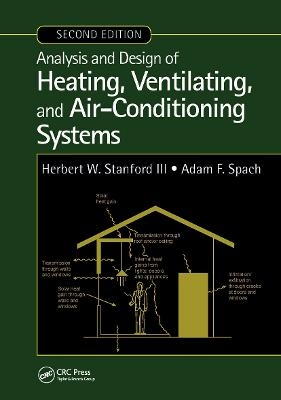
Analysis and Design of Heating, Ventilating, and Air-Conditioning Systems, Second Edition
CRC Press (Verlag)
978-1-138-60241-0 (ISBN)
Analysis and Design of Heating, Ventilating, and Air-Conditioning Systems, Second Edition, provides a thorough and modern overview of HVAC for commercial and industrial buildings, emphasizing energy efficiency. This text combines coverage of heating and air conditioning systems design with detailed information on the latest controls technologies. It also addresses the art of HVAC design along with carefully explained scientific and technical content, reflecting the extensive experience of the authors. Modern HVAC topics are addressed, including sustainability, IAQ, water treatment and risk management, vibration and noise mitigation, and maintainability from a practical point of view.
Herbert W. Stanford III, PE, is a North Carolina native and 1966 graduate of North Carolina State University with a BS in mechanical engineering. He is a registered professional engineer in North Carolina. In 1977, he founded Stanford White, Inc., an engineering consulting firm in Raleigh, North Carolina, and semiretired in 1998. Currently, Mr. Stanford is actively engaged in investigative and forensic engineering, teaching, and writing within a broad range of topics relative to buildings, especially heating, ventilating, and air-conditioning (HVAC) systems; indoor environmental quality; and building operations and maintenance. Mr. Stanford developed the Facilities Condition Assessment Program for the state of North Carolina and the Life Cycle Cost Methodology used by North Carolina to evaluate building design decisions. He has taught a series of short courses on current building topics at the University of Toledo (Ohio), North Carolina State University, and the University of North Carolina at Charlotte, and he is a life member of the American Society of Heating, Refrigerating, and Air-Conditioning Engineers (ASHRAE). Mr. Stanford is the author of HVAC Water Chillers and Cooling Towers: Fundamentals, Application, and Operation (Second Edition, CRC Press, 2011); The Health Care HVAC Technician (MGI Systems, Inc., 2008), a program and training manual for hospital HVAC maintenance personnel; and Effective Building Maintenance (Fairmont Press, 2010). Adam F. Spach was born in upstate New York and graduated from Alfred University with a BS in mechanical engineering in 2000. After graduation, he relocated to North Carolina and has called it his home since. Mr. Spach has worked as an HVAC consulting engineer since 2001 and is licensed as a professional engineer in North Carolina and several other states. He joined Stanford White, Inc., Raleigh, North Carolina, in 2005 and is now an associate with that firm. He currently focuses on providing engineering services for educational (K-12 and university), commercial, recreational, research, and healthcare facilities. Mr. Spach has a passion for sustainable design in the built environment. He was appointed to the Wake County Citizen’s Energy Advisory Committee, serving as the vice chair from 2010 to 2014, and currently cochairs the High Performance Building Task Force sponsored by the North Carolina chapter of the American Institute of Architects. He has made presentations at the annual North Carolina State Construction Conference on three occasions and at the annual North Carolina Sustainable Energy Conference on five occasions. Mr. Spach routinely lectures at the North Carolina State Design School.
Section I: Basic Concepts 1. HVAC Basics 2. The Air-Conditioning Process 3. HVAC Systems Concepts Section II: The Design Method 4. HVAC Systems Design 5. Heating/Cooling Load Calculation 6. Air Tempering and Distribution 7. Duct Design 8. Piping Design Section III: Systems and Components 9. Pumps and Fans 10. Terminal Systems and Components 11. Refrigeration Systems and Components 12. Heating Systems and Components 13. HVAC Controls Section IV: Special Considerations 14. Special HVAC Design Considerations 15. Engineering Economics and Design Decision-Making 16. Building Information Modeling 17. Construction Contract Administration
| Erscheinungsdatum | 25.04.2019 |
|---|---|
| Zusatzinfo | 110 Tables, black and white; 6 Line drawings, color; 118 Line drawings, black and white; 2 Halftones, color; 8 Illustrations, color; 114 Illustrations, black and white |
| Verlagsort | London |
| Sprache | englisch |
| Maße | 178 x 254 mm |
| Gewicht | 1170 g |
| Themenwelt | Technik ► Bauwesen |
| Technik ► Elektrotechnik / Energietechnik | |
| ISBN-10 | 1-138-60241-8 / 1138602418 |
| ISBN-13 | 978-1-138-60241-0 / 9781138602410 |
| Zustand | Neuware |
| Haben Sie eine Frage zum Produkt? |
aus dem Bereich


